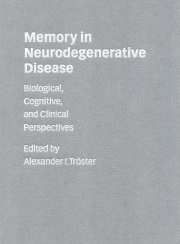Book contents
- Frontmatter
- Contents
- List of contributors
- Preface
- PART I Biological perspectives
- PART II Cognitive perspectives
- 8 The role of executive deficits in memory disorders in neurodegenerative disease
- 9 Prospective memory in aging and neurodegenerative disease
- 10 Remote memory in neurodegenerative disease
- 11 Semantic memory in neurodegenerative disease
- 12 Nondeclarative memory in neurodegenerative disease
- 13 Memory in neurodegenerative disease: what has been learned about the organization of memory?
- PART III Clinical perspectives
- Index
13 - Memory in neurodegenerative disease: what has been learned about the organization of memory?
from PART II - Cognitive perspectives
Published online by Cambridge University Press: 23 November 2009
- Frontmatter
- Contents
- List of contributors
- Preface
- PART I Biological perspectives
- PART II Cognitive perspectives
- 8 The role of executive deficits in memory disorders in neurodegenerative disease
- 9 Prospective memory in aging and neurodegenerative disease
- 10 Remote memory in neurodegenerative disease
- 11 Semantic memory in neurodegenerative disease
- 12 Nondeclarative memory in neurodegenerative disease
- 13 Memory in neurodegenerative disease: what has been learned about the organization of memory?
- PART III Clinical perspectives
- Index
Summary
INTRODUCTION
It is very widely believed that memories are stored where the remembered information is represented in the brain (Ungerleider 1995). Thus, distinct kinds of information will be stored in different brain regions. There is certainly evidence that most, if not all, regions of the brain show the kinds of plastic change at synapses that could underlie long-term memory (McGaugh et al. 1995). Whether the intraneuronal and organizational extraneuronal storage processes for two kinds of memory are qualitatively dissimilar cannot be determined at present, but this may be more likely if the brain regions involved have radically different cytoarchitectures (as may be the case, for example, with the cerebellum and the neocortex). Whether the encoding and retrieval of information depends on different regions from those involved in storage is also hard to determine in a principled way at present, but, for example, is likely to be the case when encoding and/or retrieval are nonroutine and require the planning of mental operations, as is often the case with episodic and semantic memory.
Structural damage to different brain regions disrupts memory for distinct kinds of information. I have suggested five broad groups of memory disorders caused by brain damage (Mayes 1988). First, there are disorders of short-term or working memory, which are selective for specific kinds of information such as phonological sequences and which are caused by parietal and possibly by frontal lobe lesions. Second, there are disorders of previously well-established semantic memory, which are caused by association neocortex lesions, particularly those affecting the temporal association neocortex.
- Type
- Chapter
- Information
- Memory in Neurodegenerative DiseaseBiological, Cognitive, and Clinical Perspectives, pp. 226 - 240Publisher: Cambridge University PressPrint publication year: 1998



